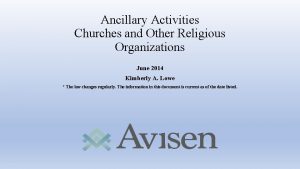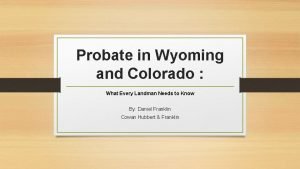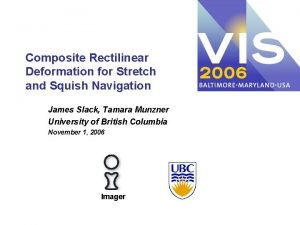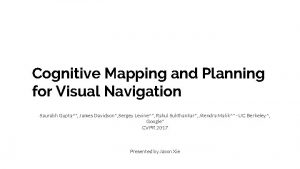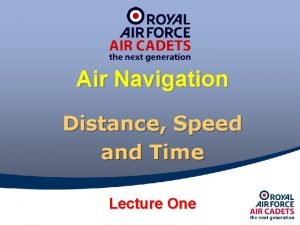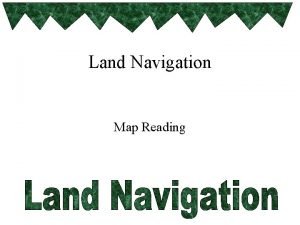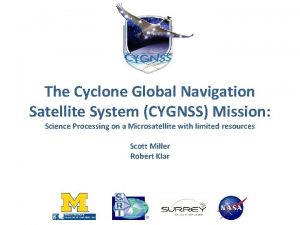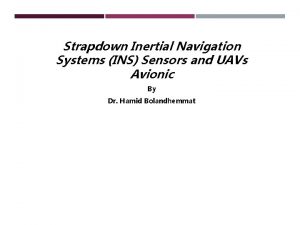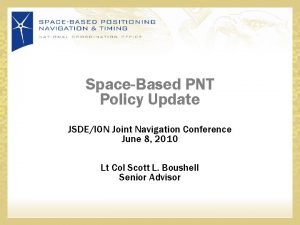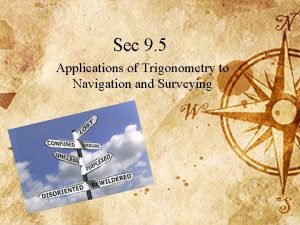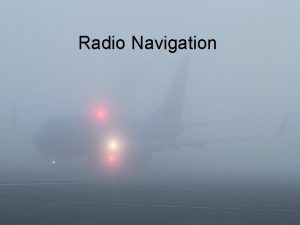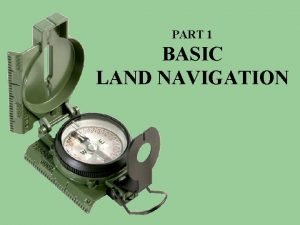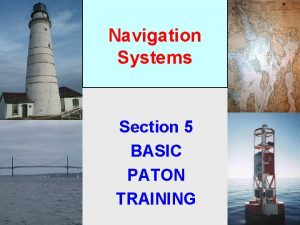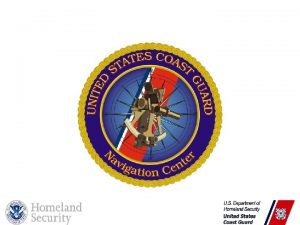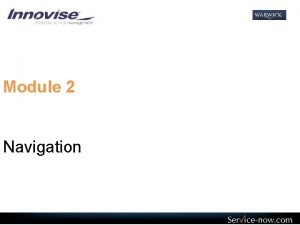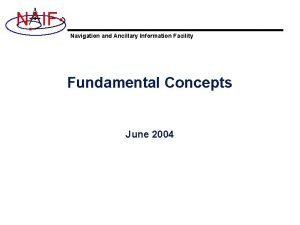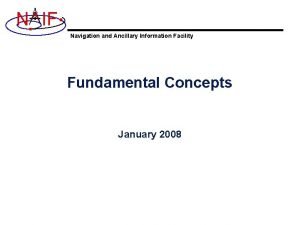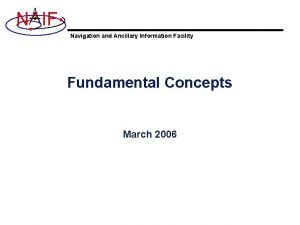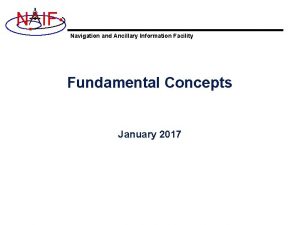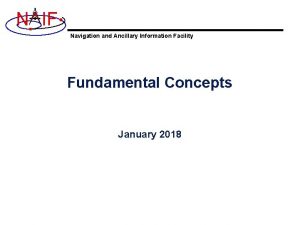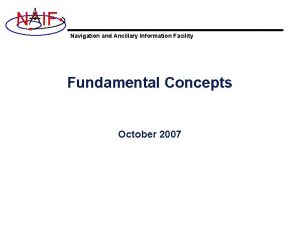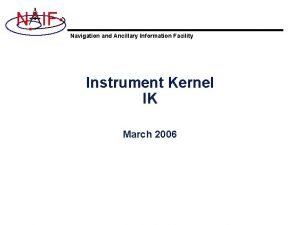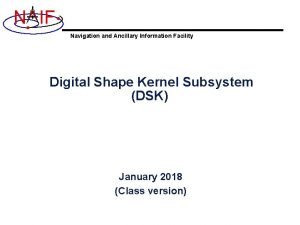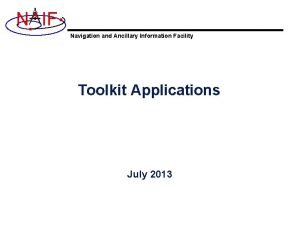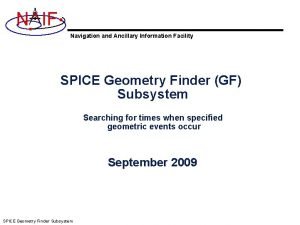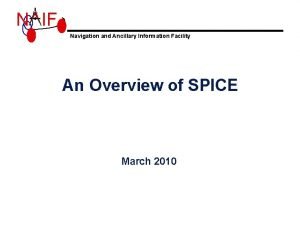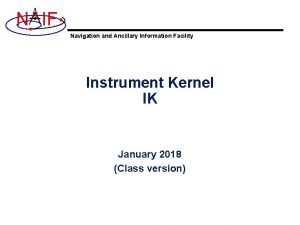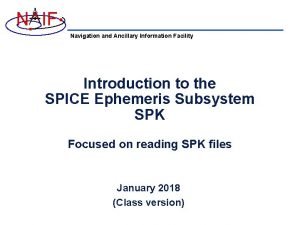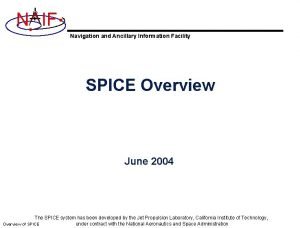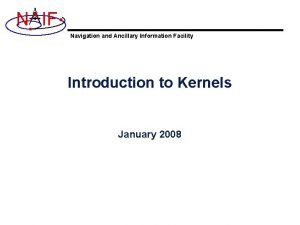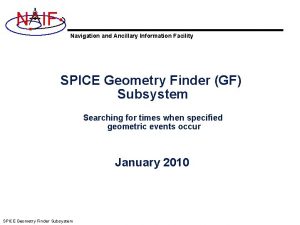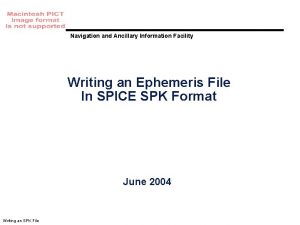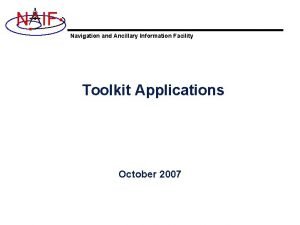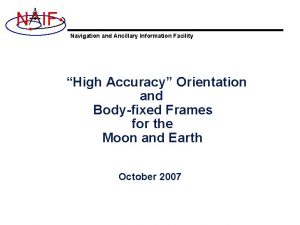N IF Navigation and Ancillary Information Facility Fundamental


































- Slides: 34

N IF Navigation and Ancillary Information Facility Fundamental Concepts April 2006

N IF Topics Navigation and Ancillary Information Facility • • • Preface Time Reference Frames Coordinate Systems Positions and States Aberration Corrections Fundamental Concepts 2

N IF Preface Navigation and Ancillary Information Facility • This tutorial introduces terminology and concepts used in the later SPICE tutorials. • Some of this material is more difficult than what follows in later presentations. – A complete understanding of this material is not essential in order to use SPICE. • Still, we think this information may be helpful, so… on we go! Fundamental Concepts 3

N IF Time Navigation and Ancillary Information Facility • An epoch is an instant in time specified by some singular event – Passage of a star across your zenith meridian – Eclipse of a spacecraft signal as it passes behind a solid body • Clocks – More mundane specifications are given as a count: “regular” oscillations of a pendulum, quartz crystal, or electromagnetic radiation from a specified source, measured from an agreed upon reference epoch. – Careful specification of epochs using clocks requires reference to the particular clock and the location of that clock. • Time Systems – Agreed upon standards for “naming” epochs, measuring time, and synchronizing clocks Fundamental Concepts 4

N IF Atomic Time and UTC Navigation and Ancillary Information Facility • International Atomic Time (TAI) – Statistical time scale » Based on data from ~200 atomic clocks in over 50 national laboratories – Maintained by Bureau International des Poids et Mesures (BIPM) – Unit is the SI (System International) second » duration of 9192631770 periods of the radiation corresponding to the transition between two hyperfine levels of the ground state of the cesium 133 atom – Count of atomic seconds past the astronomically determined instant of midnight 1 Jan 1958 00: 00 • Coordinated Universal Time (UTC) – Civil Time at Greenwich England (~GMT) – Usual Calendar Formats plus Hour: Minute: Second. fraction – UTC + 10 seconds + number of leap seconds = TAI » Valid only after Jan 01, 1972 Fundamental Concepts 5

N IF Astronomical Time Navigation and Ancillary Information Facility • Astronomical Time (UT 1) is an hour representation of the angle between the Greenwich zenith meridian and the location of the “computed mean sun. ” • Used prior to atomic time for civil time keeping UT 1 Fundamental Concepts 6

N IF Tying UTC to Earth’s Rotation Navigation and Ancillary Information Facility Ideally, UTC noon and astronomical noon at Greenwich (UT 1) should occur simultaneously. However, the earth’s rotation is not uniform. Eventually, UTC noon and astronomical noon at Greenwich get out of sync. UTC UT 1 When the mismatch becomes greater than 0. 9 atomic seconds, a “leap second” is added to (or removed from) the end of a designated UTC day—normally either June 30 or December 31. The variations in the earth’s rotation that cause leap seconds to be needed are not predictable. Fundamental Concepts 7

N IF Leapseconds (+ and -) Navigation and Ancillary Information Facility • “Normal” sequence of UTC time tags – – 1998 1999 Dec Jan 31 31 01 01 23: 59: 58. 0 23: 59. 0 00: 00. 0 00: 01. 0 Leap seconds complicate the task of finding the duration between two UTC epochs: • You need to know when past leap seconds occurred to compute durations defined by pairs of past UTC epochs. • Sequence with a Positive Leapsecond – – – 1998 1999 Dec Dec Jan 31 31 31 01 01 23: 59: 58. 0 23: 59: 60. 0 00: 00: 01. 0 • Sequence with a Negative Leapsecond – – 1998 1999 Dec Jan 31 31 01 01 23: 59: 57. 0 23: 59: 58. 0 00: 00. 0 00: 01. 0 • Durations defined by pairs of future UTC epochs are indeterminate if leap seconds could occur in the interim. Fundamental Concepts 8

N IF Barycentric Dynamical Time Navigation and Ancillary Information Facility • Barycentric Dynamical Time (TDB) and Ephemeris Time (ET) are synonyms in SPICE documentation. • TDB is – Mathematical Ideal used in the equations of motion. – Used as the independent time variable for many SPICE subroutine interfaces. – Related to ideal Time at the Solar System Barycenter (TCB) by a scale factor, so that TDB advances on average at the same rate as TAI. Fundamental Concepts 9

N IF Terrestrial Dynamical Time Navigation and Ancillary Information Facility • Terrestrial Dynamical Time (TDT) – IAU has adopted the name “Terrestrial Time” (TT) » But called TDT throughout SPICE documentation – Ideal Time (proper time) on Earth at sea level – TDT = TAI + 32. 184 seconds • TDB and TDT have same reference epoch (approximately 1 Jan 2000, 12: 00 at Greenwich England) • TDB and TDT advance at different rates. – Variations are small ~ 1. 6 milliseconds – Variations are periodic with a period of 1 sidereal year (to first order) – Variations are due to relativistic effects » TDB = TDT + 0. 001657 sin( E + 0. 01671 sin(E) ) • Use of TDT in the SPICE system is quite limited. – SCLK kernels – Duration computations involving UTC Fundamental Concepts 10

N IF Spacecraft Clocks Navigation and Ancillary Information Facility • Spacecraft have onboard clocks to control scheduling of observations, maneuvers, attitude adjustments, etc. • Used to time stamp data • Fundamental unit of time is the “tick” – Smallest increment possible for spacecraft clock • Spacecraft clock time is a count of ticks since some reference tick. • The duration of the tick drifts with respect to other time systems. Fundamental Concepts 11

N IF More about Spacecraft Clocks Navigation and Ancillary Information Facility • SCLK string formats vary from one spacecraft clock to the next. – Cassini: Maximum reading for partition 1 = 1/4294967295. 255 » Partition number: 1 » Seconds: 4294967295 » Ticks (for Cassini, unit = 1/256 second): 255 – Galileo: Maximum reading for partition 1 = 1/16777215: 90: 09: 07 » Partition number: 1 » "RIM" count (unit = 60 2/3 seconds): 16777215 » "Mod 91" count (unit = 2/3 second): 90 » "RTI" count (unit = 1/15 second): 9 » "Mod 8" count (unit = 1/120 second): 7 • Format of spacecraft clock and relationship between tick count and other time systems (usually UTC) is captured in a SPICE SCLK kernel – Pronounced “ess-clock” » sometimes the more vulgar “sclock” pronunciation is used Fundamental Concepts 12

N IF Reference Frames: Definition Navigation and Ancillary Information Facility • A reference frame is an ordered set of three mutually orthogonal (possibly time dependent) unit-length direction vectors, coupled with a location called the frame’s “center” or “origin. ” – SPICE documentation frequently uses the shorthand “frame. ” – A reference frame is also called a “basis, ” but SPICE documentation very rarely uses this term. Fundamental Concepts 13

N IF Reference Frame Center Navigation and Ancillary Information Facility • A frame’s center is an ephemeris object whose location is coincident with the origin (0, 0, 0) of a reference frame. – The center of the IAU_<body> frame is <body>. – The center of any inertial frame is (in SPICE) the solar system barycenter. » Even for frames naturally associated with accelerated bodies, such as MARSIAU. • A frame’s center plays little role in specification of states – Origin cancels out when doing vector arithmetic » Whether positions of objects A and B are specified relative to centers C 1 or C 2 makes no difference: (A – C 1) – ( B – C 1 ) = ( A – C 2 ) – ( B – C 2 ) = A – But the center *is* used in computing light time to centers of non-inertial frames » When the aberration-corrected state of Titan as seen from the Cassini orbiter is computed in the body-fixed IAU_Titan frame, light time is computed from Titan’s center to the Cassini orbiter, and this light time is used to correct both the state and orientation of Titan. Fundamental Concepts 14

N IF Types of Reference Frames Navigation and Ancillary Information Facility • Inertial – Non-rotating » With respect to fixed stars – Non-accelerating origin » Velocity is typically non-zero; acceleration is negligible – Examples: » J 2000, B 1950 • Non-Inertial – Examples » Body-fixed • Centered at body center • Topocentric » Instrument » Dynamic frames • For example, frames defined by time-dependent vectors Fundamental Concepts 15

N IF Frames Defined by Dynamics Navigation and Ancillary Information Facility • Mean Equator – Model gives mean direction of north pole of earth accounting for precession – Defines z-axis of frame – Defines a mean plane of equator • Mean Ecliptic – Model gives mean direction of the “pole” of the earth's orbit – Defines a mean plane of the ecliptic • Intersection of planes at a particular epoch determines x-axis Fundamental Concepts Ecliptic Plane 16

N IF J 2000 Frame Navigation and Ancillary Information Facility Fundamental Concepts 17

N IF Rotating Frames Navigation and Ancillary Information Facility • Rotating frames rotate with respect to Inertial Frames. Directions of axes are not constant w. r. t. inertial frames • Centers may accelerate • Examples: – Body-fixed frames are tied to the surface of a body and rotate with it. – Spacecraft-fixed frames are defined by the time-varying orientation of a spacecraft Fundamental Concepts 18

N IF IAU Bodyfixed Frames Navigation and Ancillary Information Facility • Defined with simple models for position of spin axis and motion of prime meridian • Z-axis points to the “north” side of the invariable plane of the solar system • Invariable plane is perpendicular to the angular momentum vector of the solar system Fundamental Concepts IAU = International Astronomical Union 19

N IF Topocentric Frames Navigation and Ancillary Information Facility z points “up” • Topocentric frames are attached to a surface • Z-axis is parallel to the gravity gradient or orthogonal to reference spheroid y points West Position Vector x points North Azimuth (increases in clockwise direction, measured from +x axis) Elevation (angle between vector and x-y plane) One example of a topocentric frame. There are other types of topocentric frames: for example, the z-axis could point down, the xaxis North, and the y-axis East. Fundamental Concepts Orthogonal projection of vector onto x-y plane 20

N IF Spacecraft and Instrument Frames Navigation and Ancillary Information Facility • Defined relative to structures – Spacecraft – Scan platform – Instrument » For example you might have: • z-axis lies along instrument boresight • x and y axes defined by instrument characteristics Fundamental Concepts 21

N IF State Vectors Navigation and Ancillary Information Facility • The state of an object is its position and velocity relative to a second object – In SPICE, these objects are often referred to as “target” and “observer” or “center” – E. g. Saturn relative to Saturn barycenter; Titan relative to Huygens probe • In the SPK subsystem a state is a six dimensional vector – First three components are Cartesian position: x, y, z – Second three components are Cartesian velocity: dx/dt, dy/dt, dz/dt – Units are km, km/sec • A state is specified relative to a reference frame Fundamental Concepts 22

N IF Transforming States Navigation and Ancillary Information Facility • To perform algebraic operations on states they must be in the same frame. • Position-only frame transformations require only a rotation* matrix given as a function of time. » PB (t) = RA to B(t) PA(t) • Position and velocity frame transformations require that we differentiate the above equation » d. PB (t) /dt = d. RA to B(t)/dt PA(t) + RA to B(t) d PA(t)/dt • We can use a 6 x 6 matrix to combine these two transformations into a single equation Fundamental Concepts * Assuming both frames are right-handed 23

N IF Transforming States Navigation and Ancillary Information Facility SB(t) = TA to B(t)SA(t) where Si(t) = ( ) Pi(t) d. Pi(t)/dt i = A or B and TA to B(t) = ( RA to B(t) 0 d. RA to B(t)/dt RA to B(t) ) The SPICELIB routines SXFORM and PXFORM return state transformation and position transformation matrices respectively. Fundamental Concepts 24

N IF Coordinate Systems Navigation and Ancillary Information Facility • Planetocentric – Latitude: measured from X-Y plane – Longitude: increases counterclockwise w. r. t. the +Z axis » +Z points to the north side of the invariable plane – Radius: measured from center of object • Planetographic, Geodetic, Planetodetic – Tied to a reference surface – Latitude: for a point on a reference ellipsoid, angle measured from X-Y plane to the isurface normal at the point of interest. For other points, equals latitude at the nearest point on the reference ellipsoid. – Longitude » -odetic: same as for planetocentric » -ographic: longitude of sub-observer point, for a distant, fixed observer in the J 2000 frame, increases with time – Height above reference surface Fundamental Concepts 25

N IF Aberration Corrections: Introduction Navigation and Ancillary Information Facility • Within the SPICE system, “aberration corrections” are adjustments made to state vectors and timedependent reference frames to accurately reflect the apparent–as opposed to the actual–state and attitude of a target object as seen from a specified observer at a specified time. – Actual, uncorrected states from an ephemeris are called “geometric” states. – When computing state vectors, SPICE users may request geometric or aberration-corrected states. • Aberration corrections are needed to accurately answer questions such as: – In which direction must a remote sensing instrument be pointed to observe a target of interest? – For a given pointing direction and observation time, what target body surface location would be observed by a remote sensing instrument? – In which direction must an antenna be pointed to transmit a signal to a specified target? Fundamental Concepts 26

N IF Example: Predicted vs Actual Photo Navigation and Ancillary Information Facility We compare the predicted appearance of a photograph from an optical camera against the actual photograph. We show three predictions derived using different aberration corrections: NONE, LT ("light time only"), and LT+S ("light time plus stellar aberration"). For each prediction, we use red overlays to indicate the expected location in the photo of the images of an extended target body (for example, a natural satellite), of features on the surface of the target body, and of a star. NONE LT Predicted images using uncorrected target position and orientation and uncorrected star direction vector Predicted images using light time-corrected target position and orientation and uncorrected star direction vector Fundamental Concepts LT+S Predicted images using light time and stellar aberrationcorrected target position, light time-corrected target orientation, and stellar aberration-corrected star direction vector 27

N IF Prediction Without Corrections Navigation and Ancillary Information Facility Predicted target body, surface feature, and star image locations (in red) Actual image Using geometric target positions, target images in photos or other remote-sensing observations don’t appear at their predicted locations. Fundamental Concepts 28

N IF Light Time Corrections Navigation and Ancillary Information Facility Target’s (geometric) position and orientation at time ET Note: The angular separation of the geometric and light time corrected positions as seen by the observer has been exaggerated for readability. Target’s velocity vector Target’s angular velocity vector Target’s position and orientation at time ET-LT (light time corrected position and orientation) Light travels this path in LT seconds Observer’s position at time ET At time ET, the observer’s camera records photons emitted from the target at time ET-LT, where LT is the one-way light time. The camera "sees" the target's position and orientation at ET-LT. Fundamental Concepts 29

N IF Prediction Using Light Time Corrections Navigation and Ancillary Information Facility Predicted target body, surface feature, and star image locations (in red) Actual image Using the light time corrected target position and orientation, the predicted locations in the photo of the target image and surface features have changed, but the accuracy of the prediction may still be poor. Fundamental Concepts 30

N IF Stellar Aberration Correction Navigation and Ancillary Information Facility Target’s (geometric) position and orientation at time ET Target’s position and orientation at time ET-LT (light time corrected position and orientation) Note: The angular separation of the geometric, light time corrected, and apparent positions as seen by the observer has been exaggerated for readability. Observer’s velocity relative to SSB Target’s apparent position and orientation To the observer, light appears to travel this path Observer’s position at time ET At time ET, the observer’s camera records photons emitted from the target at time ET-LT, where LT is the one-way light time. The vector from the observer at ET to the location of the target at ET-LT is displaced by a physical phenomenon called stellar aberration. The displaced vector yields the apparent position of the target. Fundamental Concepts 31

N IF Prediction Using "LT+S" Corrections Navigation and Ancillary Information Facility Actual image Predicted target body, surface feature, and star image locations (in red) Using the light time and stellar aberration-corrected target position, light timecorrected target orientation, and stellar aberration-corrected star direction, we obtain a significantly improved image location predictions. Remaining prediction errors may be due to, among other causes, pointing error, spacecraft and target ephemeris errors, and timing errors. Fundamental Concepts 32

N IF Effect of Aberration Corrections - 1 Navigation and Ancillary Information Facility • Angular offsets between corrected and uncorrected position vectors over the time span 2004 Jan 1 --2005 Jan 1 – Mars as seen from MEX: » LT+S vs NONE: . 0002 to. 0008 degrees » LT vs NONE: . 0006 to. 0047 degrees – Earth as seen from MEX: » LT+S vs NONE: . 0035 to. 0106 degrees » LT vs NONE: . 0000 to. 0057 degrees – MEX as seen from Earth: » LT+S vs NONE: . 0035 to. 0104 degrees » LT vs NONE: . 0033 to. 0048 degrees – Sun as seen from Mars: » LT+S vs NONE: . 0042 to. 0047 degrees » LT vs NONE: . 0000 to. 0000 degrees Fundamental Concepts 33

N IF Effect of Aberration Corrections - 2 Navigation and Ancillary Information Facility • Angular offsets between corrected and uncorrected position vectors over the time span 2004 Jan 1 --2008 Jan 1 – Saturn as seen from CASSINI: » LT+S vs NONE: . 0000 to. 0058 degrees » LT vs NONE: . 0001 to. 0019 degrees – Titan as seen from CASSINI: » LT+S vs NONE: . 0000 to. 0057 degrees » LT vs NONE: . 0000 to. 0030 degrees – Earth as seen from CASSINI: » LT+S vs NONE: . 0000 to. 0107 degrees » LT vs NONE: . 0000 to. 0058 degrees – CASSINI as seen from Earth: » LT+S vs NONE: . 0000 to. 0107 degrees » LT vs NONE: . 0000 to. 0059 degrees – Sun as seen from CASSINI: » LT+S vs NONE: . 0000 to. 0059 degrees » LT vs NONE: . 0000 to. 0000 degrees Fundamental Concepts 34
 What are industrial estates in entrepreneurship
What are industrial estates in entrepreneurship Examples of ancillary activities
Examples of ancillary activities Wisc 5 descriptive categories
Wisc 5 descriptive categories Ancillary controls aircraft
Ancillary controls aircraft Ancillary area
Ancillary area Ancillary documents
Ancillary documents Elia
Elia Ancillary facilities construction
Ancillary facilities construction Probate in wyoming
Probate in wyoming Aaapl
Aaapl Fundamentals of information systems
Fundamentals of information systems New and navigation schemes selection of window
New and navigation schemes selection of window Stretch and squish navigation
Stretch and squish navigation Cognitive mapping and planning for visual navigation
Cognitive mapping and planning for visual navigation Navigation and seamanship
Navigation and seamanship Distances
Distances What is a draw in land navigation
What is a draw in land navigation Vor navigation quiz
Vor navigation quiz Us coast guard navigation center
Us coast guard navigation center Custom display in ecdis
Custom display in ecdis Daytime aid to navigation
Daytime aid to navigation Cyclone global navigation satellite system
Cyclone global navigation satellite system Terrestrial navigation meaning
Terrestrial navigation meaning Strapdown inertial navigation system
Strapdown inertial navigation system Joint navigation conference
Joint navigation conference Effects of navigation acts
Effects of navigation acts Bearings trigonometry
Bearings trigonometry Hdg navigation
Hdg navigation Performance based navigation manual
Performance based navigation manual Different types of terrain
Different types of terrain Land nav protractor
Land nav protractor Buoy
Buoy Global navigation solutions
Global navigation solutions Navcen
Navcen Slide navigation pane
Slide navigation pane

